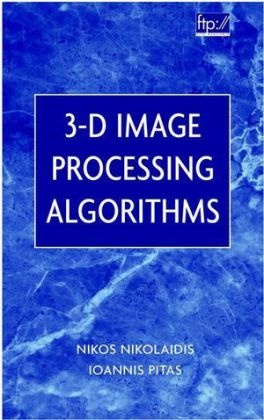Read more
Zusatztext "Explains numerous 3-D image processing! analysis! and visualization techniques! such as volume filtering! skeletonization and registration! and visualization." (SciTech Book News Vol. 25! No. 2 June 2001) Informationen zum Autor NIKOS NIKOLAIDIS, PhD , is a senior researcher in the Artificial Intelligence and Information Analysis Laboratory, Department of Informatics, Aristotle University of Thessaloniki, Greece. IOANNIS PITAS, PhD, is a professor in the Department of Informatics, Aristotle University of Thessaloniki, Greece. Klappentext Dreidimensionale Abbildungsverfahren gehören mittlerweile zu den Standardanwendungen in vielen naturwissenschaftlichen Bereichen - von der Medizin bis zur Erdbebenforschung. Die Autoren - führende Forscher auf diesem Gebiet - erläutern hier detailliert die aktuellsten und gängigsten 3-D Bildverarbeitungstechniken. Die beiliegende CD-ROM enthält eine Studentenversion des 3D-Softwarepakets EIKONA. (11/00) Zusammenfassung Three-dimensional image processing is a rapidly developing research topic that has found numerous applications in various scientific fields. These include processing and visualization of 3D medical data, image sequence processing, seismic image processing and many others. Inhaltsverzeichnis Foreword V Preface XIII Conventions and Notation XV 1 Introduction 1 2 Preliminaries 11 2.1 General Notation 11 2.1.1 Points and Sets in Euclidean Spaces 11 2.1.2 Curvatures 14 2.1.3 Measures and Measurable Spaces 17 2.2 Characteristics of Sets 18 2.2.1 The Euler Number and the Integral of Gaussian Curvature 18 2.2.2 The Mean Width and the Integral of the Mean Curvature 20 2.2.3 Intrinsic Volumes of Convex Bodies 22 2.2.4 Additive Extensions on the Convex Ring 24 2.2.5 The Principal Kinematic Formulae of Integral Geometry 25 2.3 Random Sets 26 2.3.1 Definition of Random Sets 27 2.3.2 Characteristics of Random Closed Sets 28 2.3.3 Random Point Fields 30 2.3.4 Random Tessellations 33 2.4 Fourier Analysis 34 2.4.1 Measurable Functions 34 2.4.2 Fourier Transform 36 2.4.3 Bochner's Theorem 40 3 Lattices, Adjacency of Lattice Points, and Images 43 3.1 Introduction 43 3.2 Point Lattices, Digitizations and Pixel Configurations 43 3.2.1 Homogeneous Lattices 44 3.2.2 Digitization 45 3.2.3 Pixel Configurations 46 3.3 Adjacency and Euler Number 47 3.3.1 Adjacency Systems 48 3.3.2 Discretization of Sets with Respect to Adjacency 51 3.3.3 Euler Number 52 3.3.4 Complementarity 59 3.3.5 Multi-grid Convergence 60 3.4 The Euler Number of Microstructure Constituents 61 3.4.1 Counting Nodes in Open Foams 61 3.4.2 Connectivity of the Fibres in Non-woven Materials 63 3.5 Image Data 64 3.5.1 The Inverse Lattice 65 3.5.2 The Nyquist-Shannon Sampling Theorem 66 3.6 Rendering 69 3.6.1 Volume Rendering 69 3.6.1.1 Physical Background 69 3.6.1.2 Transfer function 70 3.6.1.3 Ray Casting 71 3.6.1.4 3D Texture Mapping 72 3.6.2 Surface Rendering 72 3.6.2.1 Properties of the Reconstructed Surface 72 3.6.2.2 Marching Cube Type Algorithms 73 3.6.2.3 The Wrapper Algorithm 75 3.6.2.4 Merging and Simplification of Surface Meshes 77 4 Image Processing 79 4.1 Fourier Transform of an Image 79 4.1.1 The Discrete Fourier Transform of a Discrete One-Dimensional Signal 79 4.1.2 Fast Fourier Transform 80 4.1.3 Extensions to Higher Dimensions 81 4.2 Filtering 82 4.2.1 Morphological Transforms of Sets 82 4.2.1.1 Minkowski Addition and Dilation 83 4.2.1.2 Minkowski Subtraction and Erosion 85

